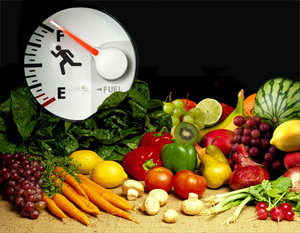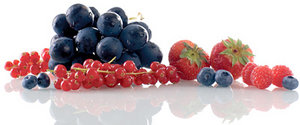What Your Body Needs
By Donald Hayes, DC
If you've ever struggled to stay awake after eating a heavy, fatty meal or tried desperately to concentrate at work on an empty stomach, you know how much food affects how your body functions. For instance, let's take a look at the standard American diet (SAD) to see why most people feel tired and rundown after lunch. Many people think nothing of eating a double cheeseburger, medium fries and a medium cola. If you dissect this "meal," you'll find that on average, it contains an unbelievable 68 grams of fat (17 teaspoons), almost half of which are saturated; 15 grams of trans fatty acids; 150 mg of cholesterol; 1,200 mg of salt; and 20 teaspoons of sugar (all from the cola)! If you factor in that the fries were probably cooked in hydrogenated cottonseed oil, one of the most heavily pesticide-laden crops in the world, and that the meat, if overcooked, could contain carcinogens, or if undercooked, could result in food poisoning from E. coli, you may agree it's time to find a new all-American meal. The Bad Guys High levels of saturated fat are consistently linked with elevated blood cholesterol levels, heart disease, insulin resistance and several forms of cancer. Most Americans eat about 40 grams of saturated fat every day, which is twice as much as is considered healthy. Animal products are the greatest source of saturated fats in the Western diet. Milk fat is more than 60 percent saturated, beef fat about 40 percent, chicken fat about 30 percent and fish fat about 20-33 percent. By comparison, plant fats are mostly in the 10-15 percent range.
 How much saturated fat should you eat? A 2002 report on diet and disease from the World Health Organization and the United Nations suggests optimal intake of no more than 7 percent of your total daily calorie intake. If you are eating 1,600 calories a day, you could choose to eat 4 ounces of steak, which will provide 10 grams of saturated fat, keeping you under the limit of 12 total grams. However, if you opt to eat 8-12 ounces of steak, you would be way over the top. On the other hand, if you skip the meat and stick to plant foods, you could eat 10 servings of fruits and vegetables, six servings of whole grains, one serving of beans, one serving of tofu, 1 ounce of nuts and 1 ounce of seeds - and still come in under your goal of no more than 12 grams of saturated fat!
How much saturated fat should you eat? A 2002 report on diet and disease from the World Health Organization and the United Nations suggests optimal intake of no more than 7 percent of your total daily calorie intake. If you are eating 1,600 calories a day, you could choose to eat 4 ounces of steak, which will provide 10 grams of saturated fat, keeping you under the limit of 12 total grams. However, if you opt to eat 8-12 ounces of steak, you would be way over the top. On the other hand, if you skip the meat and stick to plant foods, you could eat 10 servings of fruits and vegetables, six servings of whole grains, one serving of beans, one serving of tofu, 1 ounce of nuts and 1 ounce of seeds - and still come in under your goal of no more than 12 grams of saturated fat! For many years, trans fatty acids were considered a relatively minor player in health and disease. Although their impact on total cholesterol is not quite as profound as it is with saturated fats, the overall damage to heart health is worse. Trans fatty acids not only raise total cholesterol, but also lower HDL cholesterol ("good" cholesterol) and potentially increase triglycerides. Gram for gram, the adverse effect of trans fatty acids is estimated to be two to four times greater than that of saturated fatty acids. Leading research suggests intakes of trans fatty acids should be less than 1 percent of calories. For someone eating 1,600 calories a day, that amounts to no more than 1.8 grams of trans fatty acids. In real life, that means you should avoid or minimize foods that contain hydrogenated fats or partially hydrogenated fats. The most common sources are crackers, cookies, granola bars, chips and other snack foods, baked goods, margarine, shortening and deep-fried fast foods. Trace amounts in breads, seasonings and other products are not as much of a concern. Cholesterol is made by animals, not plants; all animal foods contain cholesterol, while plant foods are all cholesterol-free. The next time you buy any plant-based food like peanut butter that says "no cholesterol" on the label, realize that is just a sales gimmick. There are several concerns about eating too much cholesterol because it can cause blood cholesterol levels to rise, increasing the risk of blood clots, heart attack and stroke. The recommended daily intake of cholesterol is less than 200 mg, which is a little less than the amount of cholesterol in one egg yolk. By the way, the average American eats approximately 400 mg of cholesterol a day. The Good Guys Most people think that once they get rid of "the bad guys," there's nothing more they can do to improve their diet and health. Not true! While getting rid of unhealthy foods is an important first step, it's only half the battle. The other half is much more enjoyable: adding a wide variety of delicious and nutritious foods. You should begin by building a solid foundation of whole-plant foods that shifts the balance away from harmful components that promote fatigue and disease toward those foods that nourish and help the body thrive. Science has known for a very long time that vegetables, fruits, whole grains, beans, nuts and seeds are healthful foods. Researchers assumed that the substances that made these foods so good for us were the vitamins, minerals and fiber. They were right, but only partly. In the past 20 years, scientists have discovered a whole new set of protective compounds packed within every whole-plant food: phytochemicals and antioxidants. Phytochemicals are natural substances that protect plants against attacks from insects. When we eat plants, these same powerful little protectors go to work on our behalf, with remarkable human health benefits. Many phytochemicals are strong antioxidants, neutralizing destructive free radicals. Some phytochemicals provide anticancer support, helping the body rid itself of potent carcinogens. Others protect against cardiovascular disease by helping to reduce the formation of cholesterol, lower blood pressure, decrease blood cholesterol levels, reduce blood clot formation, open blood vessels and decrease damage to blood vessel walls. The list of significant beneficial activities of phytochemicals includes anti-inflammatory, anti-yeast, antibacterial, antifungal, antiviral and immune-enhancing benefits. Which foods are the most efficient phytochemical factories? Vegetables and fruits stand out as being particularly important, although legumes (beans), grains, nuts and seeds are also excellent sources. Choosing a wide variety of colorful, whole-plant foods is the key to a phytochemical-rich diet.
 Many people wonder if they can just pop a pill to get their phytochemicals (e.g., taking a multivitamin that contains lutein). For many reasons, we are much better off eating whole foods than simply relying on extracts. At this time, we just don't know enough about the complicated interactions of the full range of nutrients in whole foods to be confident about isolating out certain ones as pills.
Many people wonder if they can just pop a pill to get their phytochemicals (e.g., taking a multivitamin that contains lutein). For many reasons, we are much better off eating whole foods than simply relying on extracts. At this time, we just don't know enough about the complicated interactions of the full range of nutrients in whole foods to be confident about isolating out certain ones as pills. As a quick and convenient alternative to eating the whole food, you might consider supplementing once a day with a high-quality whole-food drink mix that contains a variety of fruits, vegetables and other superfoods. Typically, when using this type of whole-food nutritional powdered supplement, one scoop in water or juice will provide the antioxidant power of multiple servings of fruits and vegetables. Be sure to ask your health care provider for a recommendation because many on the market use synthetic sweeteners that raise blood sugar or use chemical or technological modifications that can harm the natural state of the fruits and vegetables. Hopefully this gives you a good starting point for improving your health. Limit your intake of saturated fat, trans fatty acids and cholesterol, and eat more whole foods, including seven to 10 servings of fruits and vegetables every day to maximize your phytonutrient and antioxidant protection. Whether you're at home or on the go, it's all about replacing bad food choices with good ones to give your body what it needs.
Donald L. Hayes, DC, graduated from Western States Chiropractic College in 1977 and is the author of five health and wellness books including his latest, Weight Loss to Wellness. To learn more, visit www.greensfirst.com.
Page printed from:
http://www.toyourhealth.com/mpacms/tyh/article.php?id=1117&no_paginate=true&no_b=true
|

